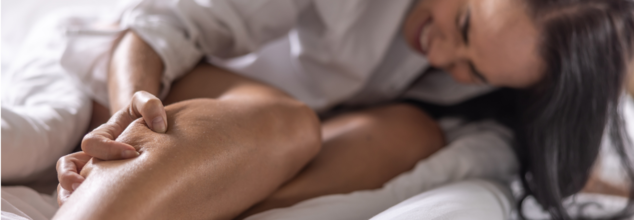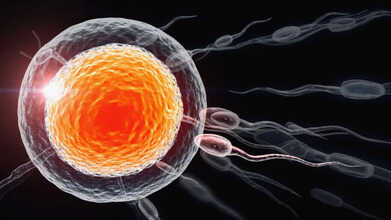- Health Conditions A-Z
- Health & Wellness
- Nutrition
- Fitness
- Health News
- Ayurveda
- Videos
- Medicine A-Z
- Parenting
Getting Sudden Muscle Spasms At Night? Blame It On Charley Horse

Muscle spasm at night
I will never forget my first encounter with a charley horse. It was in the middle of the night and I was literally woken up by a calf muscle that went from 0-60. The muscle felt like it had tensed into a rock, and I could see it twitching under my skin. It was a charley horse, which is very unpleasant, effects any muscle but mostly the leg, and is an involuntary muscle spasm or cramp in nature.
A charley horse can start suddenly and last anywhere from a few seconds to a few minutes. The pain can linger after the cramp goes away, and your muscle may feel sore for hours or even days. Muscle spasms can happen while you play sports or are exercising, or even when you’re just sitting still or lying down in bed.
Symptoms of Charley Horses
The defining symptom of a charley horse is muscle pain. The pain is often described as feeling like a hard, cramping knot, or spasm, within the muscle. And if you press gently on the muscle, you might feel a tender knot. In some cases, a visible twitching or hardening of the muscle may accompany the pain — hence the name. Charley horses are most likely to occur in the calf and thigh muscles, but you can get them in just about any skeletal muscle. Charley horses can last anywhere from a few seconds to a several minutes — or even longer. In rare cases, discomfort from a charley horse lingers for a day or two after the muscle spasm has resolved.
Causes of Charley Horses
Charley horses happen when muscles in your leg or foot tighten up without warning and it can be really painful. There are a few reasons this might happen. One is if you’ve been using the muscle too much — like by doing lots of walking or running, especially on a hard surface, or by pointing your toes for an extended period of time. (You might get one if you’re wearing high heels, for example.) Muscles that are tired or dehydrated get tight, so make sure you’re drinking enough fluids during the day, even more if you’re sweating a lot.
An imbalance of electrolytes, such as potassium and calcium, in your body can cause a muscle spasm. These minerals help your muscles contract and relax and work together for your muscles to function properly. If you have low levels of either of these minerals, you may have cramps or spasms.
Certain nerves in your body control the contractions of your muscles. If these nerves become irritated, they can cause your muscles to contract too much leading to a spasm. A herniated disk in your spine, for example, may press against a nerve root causing pain and spasms in the back muscles. Stress also tightens muscles. Tension and muscle contraction can trigger both acute and chronic neck pain.
Who is Most at Risk?
Athletes are especially susceptible to charley horses in preseason as their bodies aren’t used to such heavy activity and it can also put endurance athletes, like marathon runners and triathletes, at higher risk because of the prolonged stress on their muscles.
How to Relieve a Charley Horse
Charley horses can be treated on your own at home and will usually resolve within 10 minutes. Here’s what you can do to help the pain.
- Do not do anything or continue with the exercises you are doing, instead stop and stretch the muscle affected.
- Gently massage the muscle to help it relax.
- First apply a heating pad on the muscle and after the pain goes away, use a cold pack on the soreness.
What Is The Normal Sperm Count To Get Pregnant? Expert Explains

Credits: Canva
When talking about fertility in routine practice, we usually refer to the World Health Organization’s guideline of roughly 15 million sperm per millilitre (and around 39–40 million total per ejaculate) as the lower boundary of “normal.”
But the count alone doesn’t tell the full story. The quality of sperm, their motility, shape, and the couple’s overall reproductive health are equally important. We got in touch with Dr. Meenakshi Priya, Clinical Director & Fertility Specialist, Nova IVF Fertility, Coimbatore, who told us more about the same.
What Is The Normal Sperm Count To Get Pregnant?
Dr Meenakshi said, “Think of sperm count like lottery tickets. More tickets (higher count) give you better odds, fewer tickets lower your chances — but even one well-functioning ticket (a motile, properly shaped sperm) can win.”
That’s why fertility clinics look at several factors: concentration, total number, progressive motility (whether sperm swim forward), and morphology (shape). The WHO manual provides the standard method and cut-offs used worldwide in labs, serving as the referee for semen analysis.
However, numbers matter clinically. Research over decades shows fertility starts to drop gradually below about 40 million/ml (or in older studies, 40 million total per ejaculate was a useful marker). The WHO threshold of 15 million/ml marks the lower edge of normal — values between 15 and 40 are a “grey zone,” where conception is possible but may take longer. So a man with 12 million/ml isn’t infertile, but the couple might need help like IUI or IVF depending on other factors.
But don’t get fixated on one number. A “normal” semen report is a combination of factors:
• Concentration ≥15 million/ml
• Total sperm count ≥39–40 million per ejaculate
• Progressive motility roughly >30%
• Normal morphology about 4% (Kruger criteria)
What Changes A Sperm Count?
Lifestyle and health have a big impact on sperm. Smoking, heavy drinking, extra weight, prolonged heat exposure (saunas, hot tubs, tight underwear), certain medications, recent fevers, and conditions like varicocele or hormonal imbalances can all lower the numbers.
The good news? Most of these are reversible. Dr Meenakshi said, “Quitting smoking, reducing alcohol, losing a bit of weight, avoiding hot tubs for a few months, and treating infections can improve sperm.” Remember, sperm take time to renew but it usually takes 2–3 months of healthier habits for improvements to appear in a report. Be patient; your body is making changes even if you don’t see results immediately.
When To Be Concerned And Consult A Doctor?
If semen analysis repeatedly shows very low sperm (oligozoospermia), no sperm (azoospermia), poor motility, or if a couple has been trying for a year (or six months if the woman is over 35) without success, it’s time to consult a specialist. One abnormal test isn’t the final word — tests are usually repeated, and a more thorough assessment may include hormone checks, ultrasounds, or genetic tests if needed.
Dr Meenakshi said, “Sperm count gives a headline, not the full story. It’s a useful screening tool, but fertility decisions are personal. If you’re concerned, get a proper semen analysis and speak with a fertility specialist — many fertility issues are treatable, and acting early makes a real difference.”
Norovirus 2025: How Contagious Is the Stomach Bug Spreading Across the US

Credits: Canva
Norovirus, often called the stomach bug, has returned. Between August 1 and December 11, health officials recorded 268 norovirus outbreaks, with numbers climbing steadily as winter travel increases and more people spend time indoors. The virus triggers stomach-related symptoms such as nausea, vomiting, diarrhea, and abdominal pain or cramping.
Some people also develop fever, headaches, and body aches. Although case numbers are not rising as sharply as flu, doctors remain concerned because norovirus spreads extremely easily. Making matters worse, norovirus is difficult to kill. Many of the common precautions used against flu and COVID offer little protection against this so-called winter vomiting bug.
How Contagious Is the Norovirus?
Norovirus is among the most infectious viruses doctors deal with. “It can tear through a household and then circle back, with people repeatedly passing it to each other,” says Amy Edwards, MD, associate professor of pediatrics at Case Western Reserve University School of Medicine in Cleveland, Ohio, who specializes in infectious diseases. “It also spreads very quickly in crowded, closed settings like cruise ships.”
While contaminated surfaces can transmit norovirus, doctors say person-to-person spread is most common. An infected person can pass on the virus even before symptoms appear, throughout the illness, and after they start to feel better, Jennings warns.
What to Do If You Get Norovirus?
For most people, norovirus symptoms ease within a few days, according to Jennings. However, the illness can be more serious for those with weaker immune systems, including young children, older adults, and people with certain health conditions.
If you think you have norovirus, focus on staying well hydrated. Ongoing vomiting can quickly lead to fluid loss and electrolyte imbalance. To prevent nausea from getting worse, Jennings recommends taking small sips of clear fluids like water, ginger ale, or coconut water.
Most importantly, seek medical care right away if you become dehydrated or if diarrhea lasts for weeks. Fischer explains that dehydration may cause sunken eyes, less frequent urination, dry skin and mouth, and extreme tiredness.
Common Norovirus Symptoms That You Should Be Aware Of
Norovirus symptoms often come on suddenly and may include:
- Nausea
- Vomiting
- Stomach pain or cramps
- Watery or loose diarrhea
- General feeling of illness
- Mild fever
- Muscle aches
Symptoms usually begin 12 to 48 hours after exposure and last for one to three days. Even after recovery, people can continue shedding the virus in their stool for weeks. In some cases, especially among those with other medical conditions, shedding can continue for months. Some people infected with norovirus never develop symptoms at all. Even so, they can still spread the virus to others.
Norovirus Causes
Norovirus spreads very easily from one person to another. Because it is highly contagious, an infection can pass quickly through homes, schools, or other shared spaces. The virus is released through stool and vomit, and a person can spread it from the moment symptoms begin until several days after they feel better. Norovirus can also survive on surfaces and objects for days or even weeks.
You can catch norovirus by:
- Eating food that has been contaminated
- Drinking unsafe or contaminated water
- Touching your mouth after your hands have come into contact with a contaminated surface or object
- Having close contact with someone who is infected with norovirus
Norovirus is especially hard to get rid of because it can survive extreme hot and cold temperatures and is resistant to many common disinfectants.
Using Bisoprolol? NHS Advises Patients To Watch For These Side Effects

Credits: Canva
The NHS has issued fresh advice for people taking a widely prescribed medicine used to manage heart and circulation conditions. Across the UK, millions rely on beta-blockers to treat heart and blood vessel problems. Each year, more than 50 million prescriptions are written for these drugs, which help manage issues ranging from high blood pressure and abnormal heart rate to certain conditions affecting the brain and nervous system. Doctors most commonly prescribe bisoprolol, which NHS England lists as the seventh most prescribed medicine in the country.
What Is Bisoprolol Used For?
Bisoprolol, sold under brand names such as Zebeta, Bisotab, and Concor, belongs to a group of medicines called beta-blockers. It is mainly used to treat various heart-related conditions by slowing the heart rate and relaxing blood vessels. This reduces strain on the heart and helps it pump blood more efficiently, according to the CDC. The NHS also explains that bisoprolol is used to prevent chest pain caused by angina and to manage atrial fibrillation and other irregular heart rhythms. By slowing the heart, it allows the heart muscle to work more effectively.
Data from 2024–25 shows that bisoprolol was dispensed around 32 million times in England alone. The NHS notes that for people with high blood pressure, taking bisoprolol can help lower the risk of future heart disease, heart attacks, and strokes.
Bisoprolol Side Effects: Why Is NHS Warning Against Bisoprolol?
Like most medicines, bisoprolol can cause side effects, and patients are advised to stay alert to them. People starting the medication are often told to take their first dose at night, as it can make some feel dizzy. There are several common side effects that affect more than one in 100 people. According to the NHS, these are usually mild and tend to settle over time. They include:
- feeling dizzy or sick
- headaches
- cold hands or feet
- constipation
- diarrhoea
However, there are less common but more serious side effects that should not be ignored, as they may require urgent medical attention. The NHS advises contacting a doctor or calling 111 if:
- you experience shortness of breath with a cough that worsens during physical activity, swelling in the ankles or legs, or an irregular heartbeat, as these can point to heart problems
- the whites of your eyes or your skin turn yellow, which may be harder to notice on darker skin tones, as this can signal liver issues
Bisoprolol Warning: When Should You See Medical Emergency
The NHS also urges people to seek immediate help if certain symptoms appear. These include:
- chest pain, which could indicate heart trouble
- shortness of breath, wheezing, or tightness in the chest, which may suggest lung-related problems
Emergency services should be contacted straight away if there are signs of a severe allergic reaction, known as anaphylaxis. The NHS says to call 999 immediately if:
- your lips, mouth, throat, or tongue suddenly swell
- you are breathing very fast or struggling to breathe, with wheezing or a choking sensation
- your throat feels tight or you have difficulty swallowing
- your skin, lips, or tongue turn blue, grey, or pale, which may be more visible on the palms or soles in people with darker skin
- you suddenly feel very confused, extremely drowsy, or dizzy
- someone collapses and cannot be woken
- a child becomes limp, floppy, or unusually unresponsive, with difficulty holding their head up or focusing
The NHS stresses that while bisoprolol is effective and widely used, knowing when side effects are harmless and when they signal an emergency is key to staying safe.
© 2024 Bennett, Coleman & Company Limited

